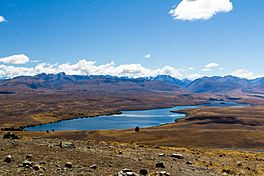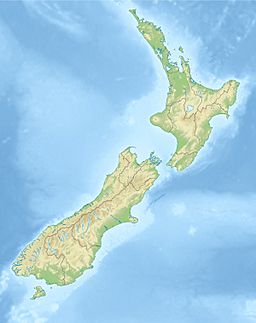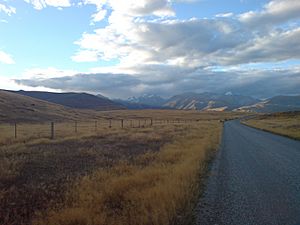Lake Alexandrina (New Zealand) facts for kids
Quick facts for kids Lake Alexandrina |
|
|---|---|

A view of Lake Alexandrina from the top of nearby Mount John
|
|
| Location | Mackenzie District, Canterbury region, South Island |
| Coordinates | 43°57′S 170°27′E / 43.950°S 170.450°E |
| Type | Mesotrophic |
| Basin countries | New Zealand |
| Max. length | 7.2 kilometres (4.5 mi) |
| Max. width | 0.9 kilometres (0.56 mi) |
| Surface area | 640 hectares (1,600 acres) |
| Max. depth | 27 metres (89 ft) |
| Residence time | 4 years |
| Surface elevation | 732 m (2,402 ft) |
Lake Alexandrina (Māori: Whakatukumoana) is a lake found in the Mackenzie Basin of New Zealand's South Island. It sits just west of the much larger Lake Tekapo and east of Lake Pukaki. The lake is north of the Lake Tekapo township.
This lake is quite shallow and was formed by glaciers. It gets its water from springs and has an outlet on its eastern side. Its water flows into a smaller lake, Lake MacGregor, and then into Lake Tekapo, which is known for its milky blue color. In the dry Mackenzie Plains, Lake Alexandrina is like a green oasis, full of life. It is also a Wildlife Refuge and a great spot for fishing, famous for its brown and rainbow trout and salmon.
Contents
Exploring Lake Alexandrina's Geography
Lake Alexandrina is a high-country lake in the Mackenzie Basin of Canterbury. It is close to Lake Tekapo and even connected to it. You can reach Lake Alexandrina from State Highway 8 by taking Godley Peaks Road.
The lake is located at an altitude of 732 metres (2,402 ft) above sea level. It covers an area of 640 hectares (1,600 acres). The lake is about 0.9 kilometres (0.56 mi) wide and stretches for 7.2 kilometres (4.5 mi). Its shores are mostly flat. The deepest part of the lake is about 27 metres (89 ft).
The land around the lake has lots of wildlife. However, there is also a lot of farming, which can add many nutrients like phosphorus to the lake. The lake's water levels are kept steady by water from surface streams, groundwater, and rainfall. Water stays in the lake for about four years before flowing out.
Understanding Lake Alexandrina's Water Quality
Lake Alexandrina is known as a mesotrophic lake. This means it has a moderate amount of nutrients. Studies in the past showed levels of chlorophyll (a green pigment from plants) and phosphorus in the water.
High levels of nutrients, especially phosphorus, can come from several places. These include the land around the lake, underground water sources, animals grazing near the lake, and even human homes. These nutrients can affect the lake's water quality.
Wildlife and Plants of Lake Alexandrina
The area around Lake Alexandrina is rich in wildlife. About 45 different kinds of birds live here. These include the Australasian crested grebe, shoveler, and scaup. You can also often see black swans and ducks.
Six types of waterbirds have been seen in total. Paradise shelducks gather here in summer. They come to find a safe place when they lose their flight feathers during their moult. Tiny freshwater snails called Potamopyrgus antipodarum also live in the lake. Studies have shown that there are more male snails in shallow water than females, and snails in shallow water are often less healthy.
In 2021, the Department of Conservation reported that over 60 pairs of Australasian crested grebes were nesting near the lake's outlet. They asked visitors to stay away from the nests to avoid disturbing these special birds.
Lake Plants
The plant species Elodea canadensis does not grow well in Lake Alexandrina. This is because the lake has steep sides and strong winds, which create a lot of water movement.
Fish Life in the Lake
Lake Alexandrina is home to many brown trout, rainbow trout, and salmon. These fish are very popular with fishing fans. While there might not be a huge number of fish due to past overfishing, the fish that are caught are often quite large.
Trout, for example, can weigh about 2.5 kilograms (5.5 lb) on average. Some prize catches can be even bigger, with rainbow trout weighing up to 4.5 kilograms (9.9 lb) and brown trout up to 6.3 kilograms (14 lb). Brown trout are often found near the lake's shores, where they can find flies and insects to eat.
Protecting Lake Alexandrina
Lake Alexandrina is a special place in New Zealand. It is part of the country's Scenic Reserves, which means it is a Crown Protected Area. This helps keep it safe and beautiful.
- Threats to the Lake
In the 1980s, scientists noticed some problems with the lake. There were often algal blooms, which are large growths of algae. These blooms were caused by too much phosphorus in the water. This was a threat to the lake's wildlife and the popular fishing.
Studies showed that almost half of the phosphorus came from groundwater. Another big part came from surface water flowing into the lake. Only a small amount came from the small huts near the lake. Because of these issues, the New Zealand government made protecting the lake's water quality a top priority.
- Conservation Efforts
To fix the problem of too many nutrients in the lake, a group called the "Lake Alexandrina Steering Committee" was formed in 1984. They found that phosphorus from the huts and from farms was causing the water quality to get worse.
Other groups also studied the lake and suggested ways to protect it. These ideas included:
- Stopping the use of aerial fertilizers near the lake's shores.
- Limiting how much fertilizer farmers could use.
- Protecting streams where fish lay their eggs.
- Stopping farming right on the lake's edges.
- Stopping new huts from being built around the lake.
- Making sure homes had proper sewage systems.
These rules were put into action by the Mackenzie District Council starting in 1997. Thanks to these efforts, the large algal blooms that used to happen often in the 1980s are now rare. They only happen about once every three years, which shows the conservation work is helping!
Visiting Lake Alexandrina
Lake Alexandrina is a popular spot, especially for fishing. In 1881, thousands of trout were brought to the Mackenzie country and released into Lake Alexandrina and other nearby waters. Once the trout grew, fishing licenses were given out.
Today, Lake Alexandrina is well-known for its fishing. There are a few small fishing huts clustered at each end of the lake and near its outlet. Only rowing boats are allowed on the lake. Sailboats and motorboats are not permitted, which helps keep the lake peaceful and natural.
Panoramas





